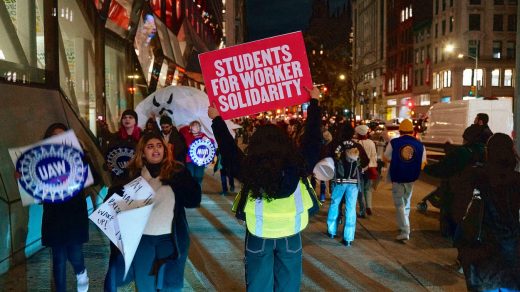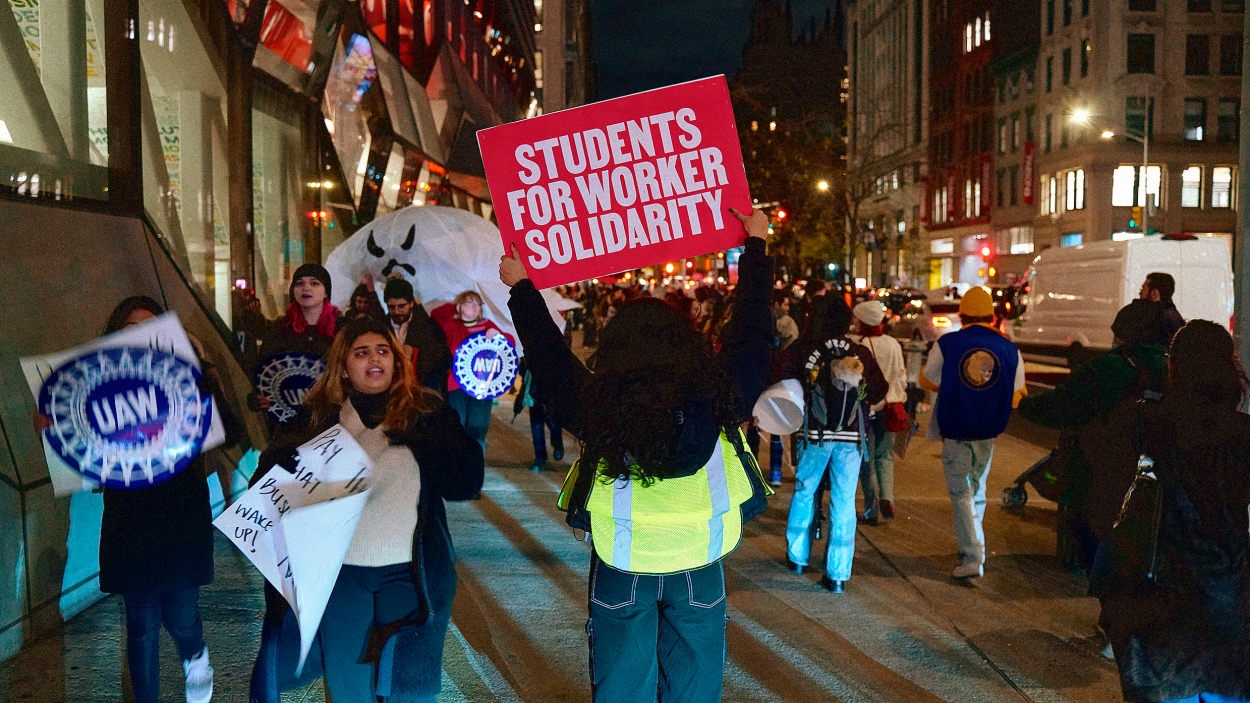The New School’s adjunct professors’ strike shows how even “good” jobs are increasingly precarious
By Kim Kelly
The longest adjunct professor strike in U.S. history concluded earlier this month, and the workers came out on top. It was a bitter 25-day struggle with the New School, a New York City institution whose conduct toward the strikers may have ultimately tarnished its progressive credentials. On December 11, the 1,800 members of ACT-UAW Local 7902 who voted to strike on November 16 reached a tentative agreement with the help of a federal mediator. Pending ratification by the union’s members, the new five-year agreement will boost wages, protect the workers’ healthcare benefits, and add paid family leave and out-of-classroom compensation, among other wins.
For those unfamiliar with the state of working in college academics, it may not have sounded like that big of a deal. Okay, the part-timers are walking out, so what? Surely the majority of the work must be shouldered by full-time tenured faculty, right? This is a world-class academic institution, after all, and the students’ tuition—which starts at more than $25,000 per year for an undergraduate degree—isn’t cheap, to say nothing of the living costs associated with attending a New York City school. All that money has to be going somewhere. Surely, it’s paying the people who are actually teaching classes, guiding students, and keeping the university running. After all, university president Dan McBride pulls down a cool $1.2 million salary. But at the New School, those untenured, part-time adjuncts make up a whopping 90% of the faculty. Their part-time status is a reflection of a predatory status quo, not their worth or workloads.
While Hollywood and prestige TV has done its best to convince us of just how sweet the life of a college professor might be—complete with light workloads, oak-paneled offices, leather-patched jackets, and starry-eyed students—it’s pure fiction for the vast majority of people actually tasked with educating college students. Adjuncts are precarious workers who are employed via short-term contracts, and are paid by the class or credit hour. Employing an army of adjuncts—sometimes called “contingent faculty” in university adminstrator speak—instead of hiring for full-time tenure-track positions has undoubtedly saved the New School a pretty penny, and is a favored cost-saving practice across academia. But those saved costs come directly out of workers’ pockets, and adjuncts at even the most prestigious, wealthy private universities often lack basic job protections, benefits, or a living wage. As The 19th’s Nadra Nittle wrote earlier this year, adjuncts often have to juggle multiple side jobs or teach classes at multiple schools in order to scrape together enough money to survive.
A recent report by the American Federation of Teachers found that 60% of the 1,900 adjuncts surveyed make less than $50,000 per year, nearly a quarter reported an annual salary below the federal poverty line, and 38% have accessed government assistance. The roots of this problem go back at least 50 years to the 1970s, when various political crises cratered the economy. Colleges and universities lost state funding, and many began trying to cut costs by hiring part-time faculty; the trend has continued ever since. This isn’t just the case at the New School: it’s everywhere, and those low wages and untenable working conditions are a major motivator behind some of the large-scale academic labor actions in recent years. Recently, 48,000 graduate student workers at the University of California came to a tentative agreement after their fifth week on strike to try and win the higher wages they so desperately need, and their struggle is just one example of the ongoing adjunct rebellion.
The New School’s reputation as a bastion of progressive, even radical thought stood in stark contrast to its administration’s behavior during the strike The school was founded in 1913 by a group of intellectuals who sought to build an institution committed to academic freedom, social change, and the creative arts. It still touts its status as a “small, progressive liberal arts college” that is “designed for fiercely independent scholars” and counts numerous celebrities and public intellectuals among its alumni. Unfortunately, its stated values have not been borne out in its actual labor practices. Contract negotiations dragged on for seven months before the adjuncts hit the bricks, and throughout the 25-day strike, the university reacted with notable hostility towards the union.
When the union engaged in the practice of open bargaining—in which any member who wishes to attend bargaining sessions can, which unions push for because it increases transparency and member involvement—the university called it a “performative” action. It also threatened to hire replacement workers to scab during the strike, and warned that, if it were to meet strikers’ demands for higher wages, it may be forced to raise tuition. As the strike wore on, the New School’s patience thinned—and tempers flared. On December 6th, three weeks into the strike, New School administrators sent out a letter detailing their intent to withhold wages and health insurance premiums from the striking workers. The move was met with vocal criticism from the workers, their supporters, and the wider academic committee, and ramped up tensions even further.
On December 8, a group called Student Faculty Solidarity announced that it would be launching an occupation of the school’s University Center. The students’ supporters have pledged to occupy the space indefinitely until their demands are met. While they initially focused on the strike, said demands have since refocused on the administration itself, and call for a number of changes, including tuition refunds and accessibility measures. They’re also calling for the resignation of president McBride, Provost Renee T. White, and the Vice President of Business and Operations Tokumbo Shobowale, as well as the seizure of the president’s plush townhouse for university community use. This isn’t the first time that a group of labor-friendly students have occupied a New School property; in 2018, students occupied the school’s cafeteria for over two weeks to protest the planned firing of 45 cafeteria workers (the workers ultimately kept their jobs).
The student occupation is ongoing, but the workers’ strike itself is finally over. At the New School, the strikers were showered with solidarity from the labor community as well as from many of the students, parents, and tenured faculty who make up their work orbit. That solidarity built strength, and ultimately got the workers a deal that they could live with and improve upon. As more adjuncts, grad students, and other academic workers continue to organize and assert their rights as workers and fight for better wages, better treatment, and a sustainable existence, the strong example set by these New School workers will undoubtedly prove inspirational. It’s living proof that change is possible. As journalist and New School adjunct Natasha Lennard tweeted jubilantly when the news broke, “WE WON! We won our fair contract. Strikes work!! Solidarity works!!!”
Kim Kelly is an independent journalist, author, and organizer whose writing on labor, politics, class, and culture has appeared in Teen Vogue, Rolling Stone, The Nation, The New York Times, The Washington Post, Columbia Journalism Review, and many other publications. Her first book, Fight Like Hell: The Untold History of American Labor, is out now via One Signal/Simon & Schuster. She is currently working on her second book.

(41)



